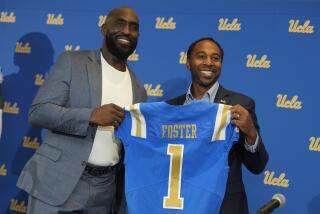When Teaching Hospitals Ail, the Cure Is a Private Matter
- Share via
Some critics contend that university presidents and chancellors spend too much time raising money and not enough on academic matters. I confess I do spend a good bit of time thinking about funding for public universities--and worrying about it, particularly about the future of the nation’s teaching hospitals.
Public resources for higher education are shrinking relative to need. The proportion of California’s budget assigned to higher education, for example, is about one-third of what it was 20 years ago. Yet, the number of students has increased and will continue to grow.
Where does the money come from to operate UCLA? Thirty percent of its budget comes from reimbursements for treatments and services at the UCLA Medical Center. About 19% comes from sales and services to cover the costs of housing, food and education materials, Another 13% comes from the federal government, almost all of which is in the form of competitive research grants.
Only 9% of UCLA’s budget comes from tuition and fees. An undergraduate student at UCLA who is a California resident will pay total student fees of less than $4,000 a year. The cost at a comparable private university is closer to $24,000, which is one of the reasons why more high school students apply to UCLA than to any other university in the country. About 7% of the budget comes from private gifts, grants and contracts from individuals and foundations.
About 21% of UCLA’s budget comes from the state, far below the 80% it once was. Our principal competition for state funds is prisons. Consequently, public universities like UCLA are much more dependent on a broad array of funding sources than in past years. In particular, they are engaged in private fund-raising, which rarely occurred until about 30 years ago. In fact, there was an unwritten rule that private universities would not seek public money, and public universities would not pursue private. That understanding is now gone on both fronts. Caltech and the University of Southern California would have a terrible time without federal support for research; and public universities, including UCLA, would be in serious trouble if not for generous support from individual and corporate donors and foundations; last year, UCLA raised $330 million from private sources.
Universities will increasingly form partnerships with industry to compensate, in part, for the inadequacy of federal and state support for research. Yet, research priorities must not be set by funding sources. The balance between the arts, humanities and social sciences, on the one hand, and science and technology, on the other, must not be determined simply by what businesses and the government will finance. Universities must research and teach all aspects of human endeavor. While federal funding for medical research has increased, federal support for the humanities has dropped dramatically, perhaps because nobody ever died from not reading Plato. This lack of government support for the arts, humanities and social sciences is a major problem for universities and for our society.
An especially critical issue is that the long-term financial stability of the nation’s teaching hospitals is seriously threatened. Every university that has a medical center with a teaching hospital faces a funding challenge. At UCLA, the academic medical center and its related units account for about $1 billion a year, including reimbursements, treatments, grants and other funding--nearly half of the university’s overall budget. Yet, UCLA hospitals will face an operating deficit this year, as will many of the teaching hospitals in the United States.
Inadequate reimbursements from Medicare and Medicaid, combined with managed-care constraints, are forcing the nation’s academic medical centers--home of the world’s most advanced medical research, training and patient care--to cut back on essential functions. Medical research, the education and training of physicians and other health-care professionals and, ultimately, the quality of patient care in the United States and throughout the world are seriously jeopardized by this dire fiscal reality. Before managed care, university-based doctors and hospitals charged higher fees for the higher-quality clinical care they provided. The revenue helped to pay for research, training the next generation of physicians and scientists and treating those who were most ill.
Teaching hospitals are a national resource. The country’s 125 university medical centers and 400 teaching hospitals train roughly 75% of the nation’s doctors, provide 44% of the health care for the poor and perform the vast majority of clinical research that advances our medical knowledge. How these critical institutions are funded at a time when some of them face losses of $100 million in a single year must be rethought. Budget deficits and staff downsizing have become common at some of the most distinguished teaching hospitals in the nation. Some will be forced to close, and those that survive will become less able to conduct unprofitable but crucial biomedical research.
Investment in university research and teaching hospitals is essential. That is why I disagree with the argument that heads of universities should spend less time on budget matters and more on the issues that really matter. The financial challenges facing public universities and teaching hospitals really do matter and are well worth our time and resources. *
More to Read
Sign up for Essential California
The most important California stories and recommendations in your inbox every morning.
You may occasionally receive promotional content from the Los Angeles Times.













